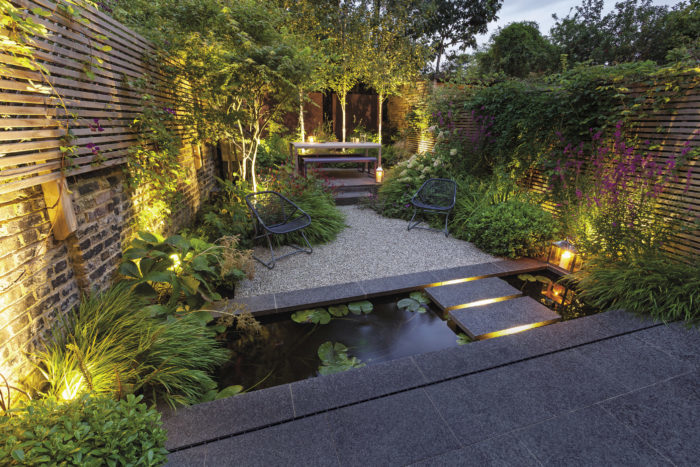
Envision being transformed by the evening ritual of lingering to reconnect with the natural world. No trip to a woodland, park, or spa is needed, however, because with the right plantings, design, and furnishings, evening restoration awaits in your own backyard. You might place a bistro set where the setting sun is visible, put chairs around a fire pit, or plant some containers for your patio. You can also create an evening landscape visible from a covered or screened porch offering shelter when rain or insects would otherwise drive you indoors.
View your after-hours garden as a place to spend personal time and a space that commemorates the end of the workday and celebrates your connections with the natural world. Just as you would design any party venue with the festivities in mind, choose plants and ornaments that add to the merriment.
Light changes everything. The setting sun can backlight fine foliage, making it appear to glow (above right), like this fountain grass (Pennisetum spp. and cvs., USDA Hardiness Zones 4–9). As daylight continues to wane, white and variegated foliage (above left) remains visible well into evening.
The more senses you excite, the better
Foliage and flower colors are especially important in an after-hours garden. Some plants show best as the sun sets, while others shine later, as the stars begin to twinkle. In early evening, red and yellow flowers or foliage is illuminated when hit by light from the sinking sun. Because the sun’s rays are traveling through more of the atmosphere as it sets, blue and violet hues are scattered along the way, leaving the red, orange, and yellow tones in these final sunbeams. These warm colors make fine-textured foliage and plants in the same shades come alive when backlit in early evening. Flowers and leaves that are red to yellow and grasses or plants with tiny leaves will glow in the warm light at sunset. When designing an after-hours garden, notice which areas of the landscape the last rays hit, and use that site for plants that are red, orange, yellow, and chartreuse, or for fine foliage.
After dark, however, those same reds and slender leaves will recede into the shadows. Pale yellows and pinks can remain visible into the evening, but blues and purples will disappear quickly as evening fades into night. Green foliage fades to gray and then black. White remains the most perceptible color from evening into night, so strategically place variegated plants and those with white flowers where they’ll be visible as the sun goes down. Remember that in the rear of the garden, larger flowers will be more striking than tiny ones. Mass smaller whites or more delicate silver plants in the foreground.
As day transitions into night and only certain colors remain visible, other senses become more important. Calming sounds and sweet fragrances create a restful environment that continues even as much of the garden disappears from view. Some of the same white flowers that remain visible as night falls are frequently the most fragrant in the evening. This is because the pollinators that these blossoms are designed to attract (nocturnal moths, for example) are smelling for plants, not looking for them. White flowers provide more easily located landing pads after the fragrance draws these pollinators in.
When considering which scented plants to use in an evening landscape, know that there are some that have very noticeable scents and others that have horticultural fragrance. The latter is what plant geeks might talk about in catalog descriptions, and it frequently means that a flower has a sweet aroma if your nose is stuck right in the blossom. A horticultural bouquet is a way of factually describing many plants such as fragrant daylilies (Hemerocallis spp. and cvs., Zones 3–10), but these scents seldom carry more than a foot from the plant. When planning an after-hours garden, look for plants with perfume that drifts several feet through the landscape.
Studies have shown that fragrances have profound effects on relaxation and our sense of well-being. They not only please in the present but also can recall simpler, happy times from the past. When planning an after-hours garden, think about pleasurable scents from the summers in your childhood and the plant fragrances you remember, then be sure to include them.
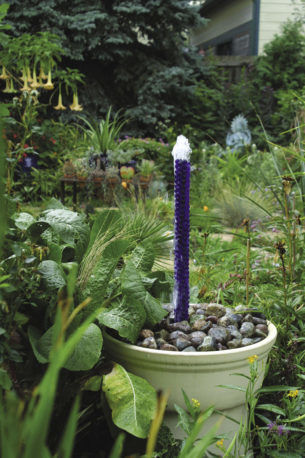
Like fragrance, the right amount of sound also helps to weave restful magic into an after-hours garden. Aside from speakers that carry music outdoors, other options can delight the ears and lift the spirits. Walk into most spas or retreats, and you’ll hear running water. It may be coming from a small tabletop fountain or a vertical waterfall, but it’s instantly soothing.
An after-hours garden is a personal oasis, and the calming sounds of water are easily achievable. From portable plug-in fountains to larger water features, falling water creates a restful ambience. Some have the space to install a pond with cascading water complete with fish and aquatic plants. Gardeners with less property might choose a smaller, pondless waterfall.
In addition to balancing the look of such structures, consider the normal environmental noises in the area. Those who live in urban spaces might want a water feature with a louder splash that can be heard over traffic, airplanes, or other sounds. In country gardens, a gentle trickle might be perfectly audible.
Water isn’t the only way to add sound to a garden. Ornamental grasses, bamboos, and trees rustle in the breeze. Air currents ring wind chimes that add to the natural chorus or distract from neighborhood noises. Frequently, these are placed a short distance away from your evening retreat so that the random chords they play blend in with the singing of birds and chirping of insects instead of commanding total attention.
When entering a garden filled with flowers, sounds, and fragrance, people smile involuntarily. This type of smile—where our cheeks rise and the skin crinkles around the eyes—is frequently called “brain changing.” The smile of pleasure as we see, hear, and smell our gardens causes neural messaging that relaxes our bodies, lowers blood pressure, and releases serotonin mood lifters. When designing a garden, use the plants, sounds, and scents that make you smile.
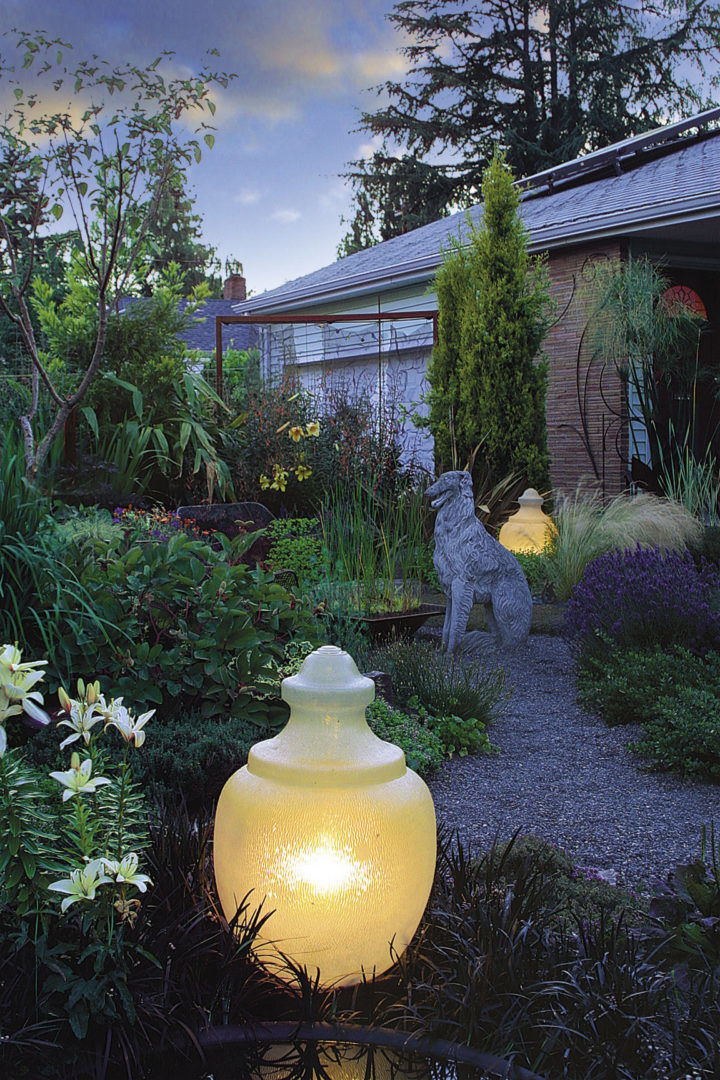
Lighting and Furniture are as important as Plants
Like white-flowering plants, lighting brightens passageways. It has the additional advantage of creating drama. Those who are fortunate enough to have a tree or large shrub with an interesting shape might install lighting that will illuminate the trunk and branches from below. But whether spotlighting a specific plant or installing lighting throughout a garden, consider using dimmer switches. Landscape illumination should never have the feel of an airport runway or mall parking lot; subtlety creates magic while providing for functional navigation.
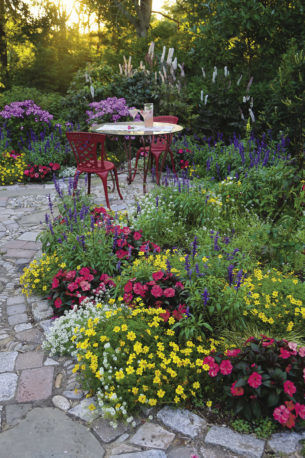
Just as lighting influences the atmosphere of rejuvenation in an after-hours garden, the choice of furniture does the same. Whether your cocktail hour contains a grouping of matched outdoor chairs and benches or a random collection of vintage pieces is a matter of individual taste. Match the furnishings to the style of plantings and the architecture of your home, considering comfort as well as appearance.
An after-hours garden changes over time, as some plants thrive and grow while others die out or are removed. The creative process is part of the fun. The goal of planting an after-hours garden isn’t just the landscape itself, however. The hardscape and plants chosen are only completed with our presence at the end of the day. So sit down, sip the beverage of your choice, inhale the fragrances deeply, enjoy the sounds around you, and absorb the wonders of the natural world.
Design Tip
Plan for Proper Placement

Plants that are fragrant, like moonflower (Ipomoea alba, annual), don’t need to be seen, but should be close enough so that their perfume will be noticed. Features and plantings that will be seen, however, need to be placed carefully. Because most people sit in their after-hours gardens, consider that perspective. When seated, what areas of your garden are in your line of sight? That’s where the most visible and interesting plants should be placed.
Design
Fire up a Fire Pit
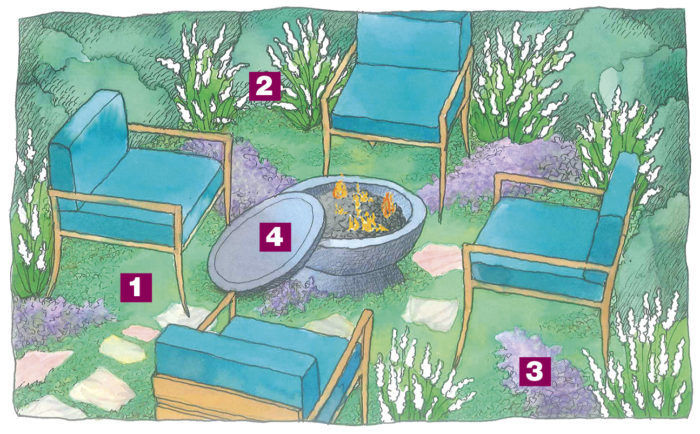
With the rising popularity of fire pits comes additional opportunities for enjoying an after-hours garden. Here are some tips for getting the maximum pleasure from a fire pit.
1. Plant the floor of the fire-pit area with thyme so that you can enjoy its herbal fragrance as you gather around the fire. Varieties that are the lowest growing include woolly thyme (Thymus pseudolanuginosus, Zones 5–8) ‘Doretta Klaber’ thyme, (Thymus praecox ‘Doretta Klaber’, Zones 3–9), and white thyme (Thymus praecox ‘Albiflorus’ Zones 3–9). All of these varieties will tolerate light foot traffic, but you’ll give them the best chance of survival and spreading if you plant them up against the pit and to the sides and rear of the chairs. In these locations, they will take hold well before spreading into the more highly trafficked areas in front of the seating around the fire pit.
2.Ring your fire-pit area with low-growing fragrance. Commonly called summersweet because of the fragrance in July and August, ‘Hummingbird’ clethra (Clethra alnifolia ‘Hummingbird’, Zones 3–9) can sweetly define the perimeter of a garden without blocking the breezes. This plant has the added advantages of golden fall-colored foliage and seeds for the birds.
3.For scented smoke, grow sage (Salvia officinalis, Zones 4–8) or similar aromatic herbs near the fire pit, and toss sprigs on the coals as they die down.
4.Use a cover on top of the fire pit to protect the bowl from rainfall and to create a table when a fire isn’t burning. There will be evenings when you might not want to build a fire but will enjoy gathering around the circle without flames. A cover provides table space for food and drinks at any time of day.
C.L. Fornari is the author of The Cocktail Hour Garden: Creating Evening Landscapes for Relaxation and Entertainment. She gardens on Cape Cod, Massachusetts.
Photos, except where noted: Nancy J. Ondra; Richard Bloom; Michelle Gervais; Jennifer Benner; C.L. Fornari. Illustrations: David Cain; Elena Medvedeva/dreamstime.com



















Comments
Log in or create an account to post a comment.
Sign up Log in